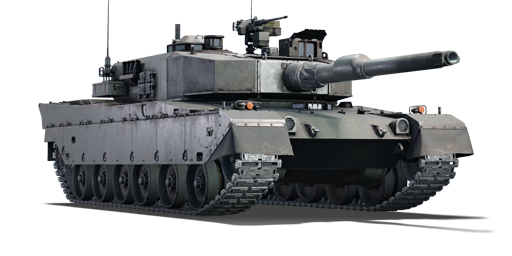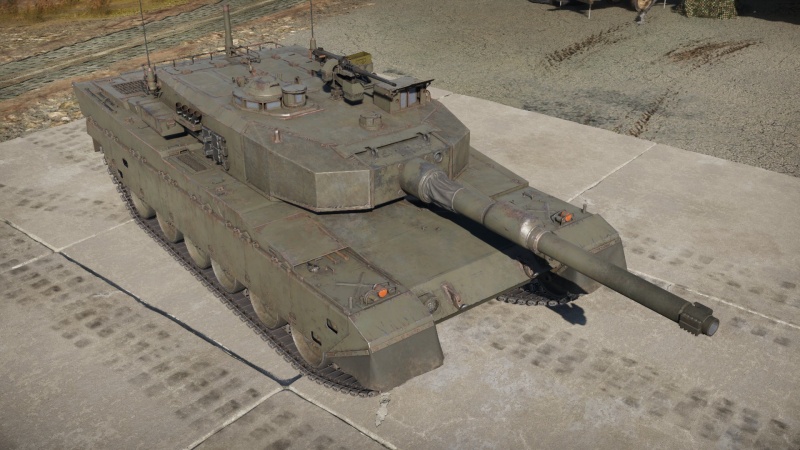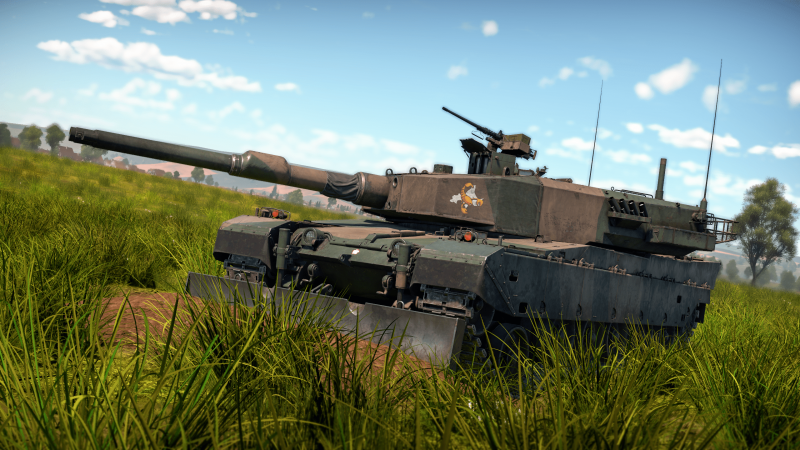Type 90
| This page is about the Japanese medium tank Type 90. For the other version, see Type 90 (Family). For other uses, see Type 90 (Disambiguation). |
Contents
Description
The Type 90 (90式戦車) was initially accepted into service in 1990 as a replacement for both the Type 61 and Type 74 models. As the Type 74 was rather late to the scene, it had to compare with the newer generation of MBTs like the T-72 (Family), Leopard 2 (Family) and M1 Abrams (Family). For that reason, the Type 90's development was called instantly after the Type 74's adoption. While closely resembling Western-style MBTs, the emphasis of the Type 90 lay in its low maximum weight and autoloader.
It was introduced in Update 1.79 "Project X". Despite its appearance being similar to the Leopard 2A4 and mounting a license-produced Rheinmetall L44-based cannon, it is significantly different in a number of aspects. In game, the main feature the Type 90 offers will be the 4-second autoloader it employs, allowing the Type 90 to effectively engage multiple targets in quick succession. The Type 90 also features a very high power-to-weight ratio putting it ahead of most other MBTs, as well as allowing it to keep up with lighter vehicles and get into position quickly.
General info
Survivability and armour
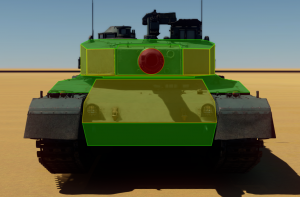
The Type 90 MBT sacrifices protection and survivability in order to attain a smaller profile and a lighter vehicle weight, which was critical to its use of Japan's many bridges. As such, most 'improved' rounds available to other MBTs at the same BR (such as the Leopard 2A5's DM33, or the Leclerc's OFL 120 F1) will punch through even the Type 90's turret cheeks or upper front plate. It's important to keep in mind that even some autocannon ammunition will easily penetrate some of the weaker sections of the Type 90 from the front.
Despite the mediocre protection, the Type 90 has one main survivability feature: its primary ammunition is stored in blowout-protected compartments, sparing the crew from side shots on the rear of the turret, providing no more than 19 rounds are carried. Unfortunately, however, due to the autoloaded cannon the Type 90 is crewed by only 3 man, increasing the chances of being disabled from an initial shot.
| Armour | Front (Slope angle) | Sides | Rear | Roof |
|---|---|---|---|---|
| Hull | 25 mm (82°) Driver's hatch 35 mm (47-83°) Upper glacis 40 mm (44°) Lower glacis |
35 mm 10 mm Side Skirts 25 mm Top |
25 mm (16-60°) All rear 15 mm Engine grille |
25 mm (0-8°) Hull roof incl. engine deck 5 mm Engine grille |
| Turret | 40 mm Cheeks incl. gunner optics 35 mm Mantlet 35 mm Rear Mantlet Plate |
40 mm Forward 33 mm + 80 mm (air) + 40 mm Middle spaced armour 12 mm + 80 mm (air) + 35 mm Rear spaced armour |
25 mm | 35 mm (78-83°) Forehead Armour 20 mm (90°) Rear turret incl. cupola |
Notes:
- Suspension wheels and tracks are 20 mm thick.
- Belly armour is 20 mm thick.
- Composite armour covers the front hull and the turret:
| Composite armour | Front (Slope angle) | Sides |
|---|---|---|
| Hull | Upper glacis 320 - 450 mm Kinetic 420 - 600 mm Chemical Lower glacis 37 - 300 mm Kinetic 20 - 380 mm Chemical |
N/A |
| Turret | Turret cheeks 400 - 450 mm Kinetic 640 - 660 mm Chemical Gun mantlet 275 - 375 mm Kinetic 500 - 600 mm Chemical |
Side forward 78 - 400 mm Kinetic 81 - 490 mm Chemical Side middle 77 mm Kinetic 80 mm Chemical |
Mobility
| Game Mode | Max Speed (km/h) | Weight (tons) | Engine power (horsepower) | Power-to-weight ratio (hp/ton) | |||
|---|---|---|---|---|---|---|---|
| Forward | Reverse | Stock | Upgraded | Stock | Upgraded | ||
| Arcade | 81 | 38 | 50.2 | 2032 | 2,862 | 40.48 | 57.01 |
| Realistic | 73 | 34 | 1327 | 1,500 | 26.43 | 29.88 | |
The Type 90 is powered by a 10-cylinder two-stroke diesel engine producing a maximum of 1,500 horsepower at 2400 RPM. Combined with its relatively light weight of only 50.2 tonnes, this gives it an excellent power-to-weight ratio of 29.88. As such, the Type 90 is often one of the first vehicles to reach capture points in a match, and can comfortably flank or move into advantageous positions earlier than many of its contemporaries. This power is transferred to the drive sprockets via an automatic transmission with 7 forward and 2 backward gears, unfortunately limiting the otherwise extremely mobile vehicle to 73 km/h (RB/SB) forwards and -34 km/h (RB/SB) backwards - speeds which it will reach with ease on-road.
The Type 90 also mounts hydropneumatic suspension, allowing it to actively change the vehicle's ride height and angle. This can be used to improve the Type 90's rather poor vertical traverse angles, taking advantage of more defensive positions.
Modifications and economy
Armaments
Main armament
The Type 90 L/44 120 mm cannon is a license-produced clone of the Rheinmetall L/44 cannon found on the Leopard 2 series and the M1A1/M1A2. As such, it shares their excellent accuracy and firepower characteristics, with a key advantage: the Type 90 is autoloaded. This results in a flat 4 second reload, better than the peak manually loaded speeds available to the other L/44-mounting vehicles (5-6 seconds). Additionally, reloads are not hindered by fire or the loss of crew members. The Type 90 has two rounds available to it; the powerful JM33 APFSDS round (based on the NATO DM33 round) and the JM12A1 HEAT-FS round (based on DM12A1). These rounds are more than capable of penetrating any opponent the Type 90 may face, although when engaging many contemporary vehicles frontally, targeting weakspots is critical.
| 120 mm Type 90 L/44 | Turret rotation speed (°/s) | Reloading rate (seconds) | ||||||||
|---|---|---|---|---|---|---|---|---|---|---|
| Mode | Capacity | Vertical | Horizontal | Stabilizer | Stock | Upgraded | Full | Expert | Aced | Autoloader |
| Arcade | 42 | -7°/+10° | ±180° | Two-plane | 28.6 | 39.5 | 48.0 | 53.1 | 56.5 | 4.00 |
| Realistic | 17.9 | 21.0 | 25.5 | 28.2 | 30.0 | |||||
Ammunition
| Penetration statistics | |||||||
|---|---|---|---|---|---|---|---|
| Ammunition | Type of warhead |
Penetration @ 0° Angle of Attack (mm) | |||||
| 10 m | 100 m | 500 m | 1,000 m | 1,500 m | 2,000 m | ||
| JM12A1 | HEATFS | 480 | 480 | 480 | 480 | 480 | 480 |
| JM33 | APFSDS | 481 | 478 | 470 | 461 | 450 | 440 |
| Shell details | ||||||||||||
|---|---|---|---|---|---|---|---|---|---|---|---|---|
| Ammunition | Type of warhead |
Velocity (m/s) |
Projectile mass (kg) |
Fuse delay (m) |
Fuse sensitivity (mm) |
Explosive mass (TNT equivalent) (kg) |
Ricochet | |||||
| 0% | 50% | 100% | ||||||||||
| JM12A1 | HEATFS | 1,140 | 13.5 | 0.05 | 0.1 | 2.15 | 65° | 72° | 77° | |||
| JM33 | APFSDS | 1,640 | 4.3 | - | - | - | 78° | 80° | 81° | |||
Ammo racks
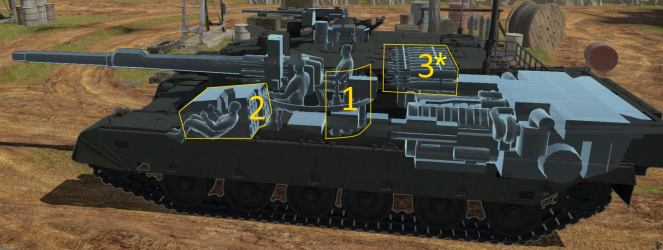
| Full ammo |
1st rack empty |
2nd rack empty |
3rd rack empty |
Visual discrepancy |
|---|---|---|---|---|
| 42 | 39 (+3) | 19 (+23) | 1 (+41) | No |
Notes:
- Hull empty: 19 (+23) shells
- The autoloader contains 18 shells. Once these have all been fired, the autoloader must be replenished before being able to fire again.
Optics and night vision
The Type 90 receives night vision imagers once the tier 3 modification 'NVD' is researched. This unlocks standard 500 x 300 resolution thermal sights for the gunner, as well as standard image intensifiers for all crew (available in third person view in AB/RB additionally).
| Type 90 Optics | ||||||
|---|---|---|---|---|---|---|
| Type of optic | Magnification | Night Vision Devices | ||||
| Image Intensifier | Thermal Imager Resolution |
Notes | ||||
| Resolution | Light Mult | Noise Level | ||||
| Gunner's Sight | 8.0x - 16.1x | -- | -- | -- | 500 x 300 | Intensifier & thermal sights unlocked by 'NVD' modification (tier 3) |
| Commander's View | 6.0x | 1600 x 1200 | 9.0 | High | N/A | Intensifier unlocked by 'NVD' modification (tier 3) |
| Driver's View | 1.0x | 800 x 600 | 5.0 | High | N/A | Intensifier unlocked by 'NVD' modification (tier 3) |
Machine guns
The Type 90 mounts two machine guns; one pintle-mounted 12.7 mm and one coaxial mounted 7.62 mm. These can be used as deterrent for low-flying aircraft, clearing light obstacles or crew from open-top vehicles, or spotting enemy vehicles.
| 12.7 mm M2HB | ||||
|---|---|---|---|---|
| Mount | Capacity (Belt) | Fire rate | Vertical | Horizontal |
| Pintle | 1,000 (200) | 577 | -8°/+60° | ±120° |
| 7.62 mm Type 74 | ||||
|---|---|---|---|---|
| Mount | Capacity (Belt) | Fire rate | Vertical | Horizontal |
| Coaxial | 4,500 (250) | 701 | N/A | N/A |
Usage in battles
The Type 90 is an extremely capable vehicle in the hands of an experienced tanker, but heed must be paid to the vehicle's weaknesses at all times.
Rural Combat
The Type 90 is very capable in rural combat where cover is plentiful and flanking routes are available. It should ideally be used for early flanks where available (such as the eastern flank on Maginot Line) or when unavailable, pushing quickly for early captures before moving to a nearby protected location to hold that point. It's important to be aware of which routes might be sniper-covered early, as most vehicles will easily penetrate the Type 90, even at range - avoid giving them the opportunity.
Urban Combat
The Type 90 can prove itself to be an excellent urban combat vehicle, primarily due to its mobility and reliably fast reload. As in rural combat, an early push for a cap can prove viable before moving into a protected position, although often by the time the capture is completed enemy targets will be nearby. Early flanking (such as around the sides of American Desert) is also viable.
Notable Targets
- Challenger 2 - The Challenger 2 is often found as a sniper due to its poor mobility but rather good turret armour. It is not recommended to fight hull-down Challenger 2s face-to-face at long range. The Challenger 2 can be penetrated frontally over large parts of the hull in addition to the poorly armoured mantlet.
- M1A2 Abrams - The M1A2 Abrams has excellent frontal protection and can prove tricky to discern from earlier models in the heat of a battle. As a general rule it's preferable to aim for the gun mantlet or turret ring on any Abrams, despite the fact that JM33 will penetrate nearly anywhere on early models - better safe than sorry.
- Leopard 2 - The Leopard 2A5 and later variants are very well protected. Once again it is not recommended to fight hull-down Leopard 2A5, 2A6 or 2A7 face-to-face at long range. Frontal weakspots on Leopard 2A7 and Strv 122s include around the gun mantlet, lower front hull and driver's hatch. Leopard 2A5/2A6 can be penetrated over a larger part of the frontal hull.
- T-80 - The T-80 family (excluding the T-80B) is well protected from the front, and care should be taken when engaging - aim for the driver viewport or the lower front plate; or where these are not options try to disable its gun through the mantlet. If flanking, side shots will often knock out the T-80 in one shot.
- Leclerc - The Leclerc is fast, with a power-to-weight ratio not far short of the Type 90's. When pushing early for caps or flanks, be aware that the Leclerc may be one of the first vehicles you'll counter. The Leclerc's highly-sloped upper plate can easily be penetrated by JM33, as can the lower plate and mantlet, and on certain variants, the armour block under the gunner's sight. The flat middle front plate and turret cheeks can reliably stop JM33 however.
Pros and cons
Pros
- Autoloaded 120 mm cannon, 4-second reload unaffected by crew or fire
- High power-to-weight ratio and top speed, excellent mobility
- Fitted with hydropneumatic suspension, allowing a greater range of vertical targeting.
- JM33 APFSDS round is competitive
- Primary ammunition storage protected within blow-out containment in the rear of the turret
- Hydropneumatic suspension can lower the tank significantly, allowing you to hide behind relatively low hills and ridges
Cons:
- Insufficient protection to reliably stop many rounds around its BR-range
- Low survivability resulting from a 3 man crew
- Poor vertical gun traverse angles, partially made up for by use of active suspension
- JM33 struggles against higher-rank opponents if not aimed at weak spots
- Rather slow targeting speeds both vertically and horizontally
History
Development of the Type 90 began almost immediately after the introduction of the Type 74 into service, with the Japanese High Command already looking for a superior replacement. A central aspect of the new machine would have to be the ability to take on and defeat the new Soviet T-72 main battle tank. With that in mind, Japanese engineers began working on a prototype design, which would see completion in 1980. Two prototypes of this initial design were built, tested and improved upon between 1980 - 1986.
Testing resumed in 1986 with a second batch of four prototype vehicles, featuring a number of improvements over the initial two. The most significant change included the replacement of a Japanese-made 120mm smoothbore gun with the established Rheinmetall 120 L/44, most notably used by the M1A1 Abrams and Leopard 2 at the time. The decision to change the gun from a domestic one to a licence-built alternative most likely came as a measure to reduce production costs. However, unlike the MBTs of western armies, the designers of the Type 90 opted to equip the tank with an autoloading mechanism, making it the only production vehicle that did so in combination with the Rh 120 cannon. Further testing and army trials of these prototypes was conducted during the late 80s before the Japanese army formally introduced the tank into service in 1990 as the Type 90. Production of the Type 90 began in 1990 and continued until 2009, with 341 vehicles made.
- From Devblog
Media
- Skins
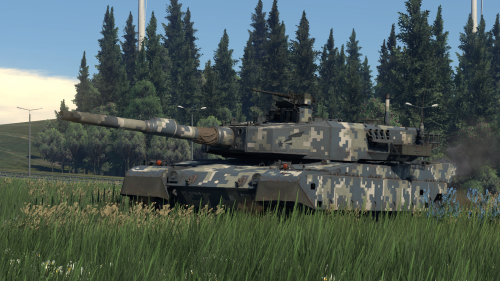
- Videos
See also
- Related Development
- Type 90 (Family)
- Type 90 (B) - (equipped with mounting plates for a Type 92 mine-roller)
- Type 90 (B) "Fuji"
- Type 10 (Family) - (successor)
- Other vehicles of similar configuration and role
External links
| Japan medium tanks | |
|---|---|
| Type 97 | Chi-Ha · Chi-Ha Kai · Chi-Ha Kai TD · Chi-Ha Short Gun |
| Type 1 | Chi-He · Chi-He (5th Regiment) · Ho-I |
| Type 3 | Chi-Nu · Chi-Nu II |
| Type 4 | Chi-To · Chi-To Late |
| Type 5 | Chi-Ri II |
| Type 61 MBT | ST-A1* · ST-A2* · ST-A3* · Type 61 |
| Type 74 MBT | ST-B2* · Type 74 (C) · Type 74 (E) · Type 74 (F) · Type 74 (G) |
| Type 90 MBT | Type 90 · Type 90 (B) · Type 90 (B) "Fuji" |
| Type 10 MBT | TKX (P)* · TKX* · Type 10 |
| Other | Ka-Chi |
| USA | ▅M4A3 (76) W · ▅M47 |
| *Prototype | |
- Ground vehicles
- Japan ground vehicles
- Seventh rank ground vehicles
- Medium tanks
- Ground vehicles with composite armour
- Ground vehicles with smoke grenades
- Ground vehicles with dozer blade
- Ground vehicles with hydropneumatic suspension
- Ground vehicles with night vision device
- Ground vehicles with thermal sight
- Ground vehicles with autoloader
- Ground vehicles with gun stabilizer


